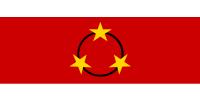South Seas Communist Party
The South Seas Communist Party (abbreviated SSCP), also called the Nanyang Communist Party (Chinese: 南洋共产党), was a communist party in Southeast Asia established in 1925 when the Communist Party of China separated its exile branches in the region to make way for local communist parties. SSCP succeeded earlier efforts by the Indonesian communist Tan Malaka to build communist parties in the region.
South Seas Communist Party Nanyang Communist Party 南洋共产党 | |
|---|---|
| Abbreviation | SSCP |
| Founded | 1925 |
| Dissolved | 1930 |
| Headquarters | Singapore |
| Ideology | Communism |
| Political position | Far-left |
The SSCP was headquartered in Singapore. In 1930 SSCP was disbanded, and national communist parties were formed such as Communist Party of Indochina (led by Ho Chi Minh), Malayan Communist Party and Communist Party of Siam.
South Seas Communist Party in Burma
A minor branch of the South Seas Communist Party was formed in Burma. The group was formed by Wu Wei Sai (alias Wu Ching Sin), who had arrived to Rangoon in May 1929. Along with his wife he conducted propaganda activities in the Rangoon Chinatown. A small group of followers was formed, but largely the establishment of a Chinese communist movement in Burma failed as the Chinese community in Burma was dominated by middle-class elements. Rangoon had relatively few Chinese labourers. Wu Wei Sai left Burma in 1930. The group that remained, the Provisional Committee, Special Division, Burma of the South Seas Communist Party, had only a handful members. Some were deported to China by the British authorities.[1]
References
- Lintner, Bertil. The Rise and Fall of the Communist Party of Burma (CPB). Southeast Asia Program series, no. 6. Ithaca, N.Y.: Southeast Asia Program, Cornell University, 1990. p. 5

